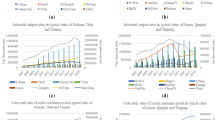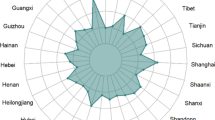Abstract
In this study, the factors affecting the index of ecological well-being performance (IEWP) in Iran were investigated from 1994 to 2014. For this purpose, the long- and short-run relationships between IEWP and per capita GDP as the indicator of economic growth, energy consumption per capita, and the population were analyzed. In addition, the well-known Stochastic Impacts by Regression on Population, Affluence, and Technology framework was used. The empirical model was evaluated by applying the autoregressive distributed lag (ARDL) approach. The ARDL bounds test was employed to investigate the long-run relationships. The results indicated the existence of a long-run relationship and cointegration. The empirical results also revealed that the relationship between economic growth and IEWP is positive and statistically significant. This indicated that Iran is located in the first stage of development. According to the empirical results, energy consumption has reduced IEWP. Therefore, the energy consumption in Iran is ecologically inefficient in improving human well-being in the short and long run. Moreover, the impact of the population is negative on IEWP and statistically significant in the short and long run. As a result, the population growth in Iran contributes to more environmental degradation and pollution. Hence, energy consumption and population development policies must align with the reduction in environmental pollution.

(source: Global Footprint Network)

Similar content being viewed by others
References
Al-Mulali, U., & Ozturk, I. (2015). The effect of energy consumption, urbanization, trade openness, industrial output, and the political stability on the environmental degradation in the MENA (Middle East and North African) region. Energy, 84, 382–389.
Asghari, M. (2012). Environmental Kuznets curve and growth source in Iran. Panoeconomicus, 59(5), 609–623.
Aşıcı, A. A., & Acar, S. (2016). Does income growth relocate ecological footprint? Ecological Indicators, 61, 707–714.
Aydin, C., Esen, Ö., & Aydin, R. (2019). Is the ecological footprint related to the Kuznets curve a real process or rationalizing the ecological consequences of the affluence? Evidence from PSTR approach. Ecological Indicators, 98, 543–555.
Bello, M. O., Solarin, S. A., & Yen, Y. Y. (2018). The impact of electricity consumption on CO2 emission, carbon footprint, water footprint and ecological footprint: The role of hydropower in an emerging economy. Journal of environmental management, 219, 218–230.
Bian, J., Ren, H., & Liu, P. (2020a). Evaluation of urban ecological well-being performance in China: A case study of 30 provincial capital cities. Journal of Cleaner Production, 254, 120109.
Bian, J., Zhang, Y., Shuai, C., Shen, L., Ren, H., & Wang, Y. (2020b). Have cities effectively improved ecological well-being performance? Empirical analysis of 278 Chinese cities. Journal of Cleaner Production, 245, 118913.
Biggeri, M., & Mauro, V. (2018). Towards a more ‘sustainable’ human development index: Integrating the environment and freedom. Ecological Indicators, 91, 220–231.
Brown, K. W., & Kasser, T. (2005). Are psychological and ecological well-being compatible? The role of values, mindfulness, and lifestyle. Social Indicators Research, 74(2), 349–368.
Caillon, S., Cullman, G., Verschuuren, B., & Sterling, E. J. (2017). Moving beyond the human–nature dichotomy through biocultural approaches: Including ecological well-being in resilience indicators. Ecology and Society, 22(4), 27. https://doi.org/10.5751/ES-09746-220427.
Charfeddine, L., & Mrabet, Z. (2017). The impact of economic development and social-political factors on ecological footprint: A panel data analysis for 15 MENA countries. Renewable and Sustainable Energy Reviews, 76, 138–154.
Chen, B., Zhang, X., Tao, J., Wu, J., Wang, J., Shi, P., & Yu, C. (2014). The impact of climate change and anthropogenic activities on alpine grassland over the Qinghai-Tibet Plateau. Agricultural and Forest Meteorology, 189, 11–18.
Common, M. (2007). Measuring national economic performance without using prices. Ecological Economics, 64(1), 92–102.
Conceição, P., Kim, N., & Zhang, Y. (2009). Economic Shocks and Human Development: A review of empirical findings. UNDP/ODS Working Paper.
Dale, V. H., Joyce, L. A., McNulty, S., Neilson, R. P., Ayres, M. P., Flannigan, M. D., & Simberloff, D. (2001). Climate change and forest disturbances: climate change can affect forests by altering the frequency, intensity, duration, and timing of fire, drought, introduced species, insect and pathogen outbreaks, hurricanes, windstorms, ice storms, or landslides. AIBS Bulletin, 51(9), 723–734.
Daly, H. E. (1974). The economics of the steady state. The American Economic Review, 64(2), 15–21.
Destek, M. A., & Sarkodie, S. A. (2019). Investigation of environmental Kuznets curve for ecological footprint: The role of energy and financial development. Science of The Total Environment, 650, 2483–2489.
Dias, R. A., Mattos, C. R., & Balestieri, J. A. (2006). The limits of human development and the use of energy and natural resources. Energy Policy, 34(9), 1026–1031.
Dietz, T., & Rosa, E. A. (1997). Effects of population and affluence on CO2 emissions. Proceedings of the National Academy of Sciences, 94(1), 175–179.
Dietz, T., Rosa, E. A., & York, R. (2009). Environmentally efficient well-being: Rethinking sustainability as the relationship between human well-being and environmental impacts. Human Ecology Review, 16(1), 114–123.
Dietz, T., Rosa, E. A., & York, R. (2012). Environmentally efficient well-being: Is there a Kuznets curve? Applied Geography, 32(1), 21–28.
Dogan, E., Ulucak, R., Kocak, E., & Isik, C. (2020). The use of ecological footprint in estimating the environmental Kuznets Curve hypothesis for BRICST by considering cross-section dependence and heterogeneity. Science of The Total Environment, 723, 138063.
Ehrlich, P. R., & Holdren, J. P. (1971). Impact of Population Growth. Obstetrical and Gynecological Survey, 26(11), 769–771.
Elistia, E., & Syahzuni, B. A. (2018). The Correlation of the human development index (HDI) towards economic growth (GDP Per Capita) in 10 ASEAN member countries. Journal of Humanities and Social Studies, 2(2), 40–46.
Fatai, K., Oxley, L., & Scrimgeour, F. G. (2003). Modeling and forecasting the demand for electricity in New Zealand: A comparison of alternative approaches. The Energy Journal, 24, 75–102.
Feng, J., & Yuan, J. (2016). Effect of technology innovation and spillovers on the carbon intensity of human well-being. Springer Plus, 5(1), 1–8.
Feng, J., Yuan, J. (2016a). On Chinese Regional Ecological Well-being Performance and Its Influence Factors. Forum on Science and Technology in China. No. 3, p. 17.
Feng, Y., Zhong, S., Li, Q., Zhao, X., & Dong, X. (2019). Ecological well-being performance growth in China (1994–2014): From perspectives of industrial structure green adjustment and green total factor productivity. Journal of Cleaner Production, 236, 117556.
Fu, W., Turner, J. C., Zhao, J., & Du, G. (2015). Ecological footprint (EF): An expanded role in calculating resource productivity (RP) using China and the G20 member countries as examples. Ecological indicators, 48, 464–471.
Ghorani-Azam, A., Riahi-Zanjani, B., & Balali-Mood, M. (2016). Effects of air pollution on human health and practical measures for prevention in Iran. Journal of Research in Medical Sciences: The Official Journal of Isfahan University of Medical Sciences, 21, 65.
Gorica, K., & Gumeni, A. (2013). Towards sustainable development: Relationship between HDI and GDP per capita in Albania. International Journal of Scientific and Engineering Research, 4(12), 3–5.
Hackl, A. (2018). Mobility equity in a globalized world: Reducing inequalities in the sustainable development agenda. World Development, 112, 150–162.
He, L., & Chen, X. (2011). Study on sustainable economic development of Shaanxi province based on ecological well-being. Research on Development, 6, 24–28.
Hou, J., Walsh, P. P., & Zhang, J. (2015). The dynamics of human development index. The Social Science Journal, 52(3), 331–347.
Hua, Z., Miao, Y., Cuiyang, S., & Jiangang, L. (2019). Relationship of ecological well-being performance and sustainable economic development in Liaoning province. Journal of Resources and Ecology, 10(1), 39–47.
Jafari, Y., Othman, J., & Nor, A. H. S. M. (2012). Energy consumption, economic growth and environmental pollutants in Indonesia. Journal of Policy Modeling, 34(6), 879–889.
Johansen, S. (1988). Statistical analysis of cointegration vectors. Journal of economic dynamics and control, 12(2–3), 231–254.
Johansen, S., & Juselius, K. (1990). Maximum likelihood estimation and inference on cointegration—with applications to the demand for money. Oxford Bulletin of Economics and statistics, 52(2), 169–210.
Jorgenson, A. K. (2014). Economic development and the carbon intensity of human well-being. Nature Climate Change, 4(3), 186–189.
Jorgenson, A. K., Alekseyko, A., & Giedraitis, V. (2014). Energy consumption, human well-being and economic development in central and eastern European nations: A cautionary tale of sustainability. Energy Policy, 66, 419–427.
Kettner, C., Köppl, A., & Stagl, S. (2014). Towards an operational measurement of socio-ecological performance (No. 52). WWWforEurope Working Paper.
Khodabakhshi, A. (2011). Relationship between GDP and Human Development Indices in India (2011). Society of Interdisciplinary Business Research (SIBR) 2011 Conference on Interdisciplinary Business Research.
Klugman, J., Rodríguez, F., & Choi, H. J. (2011). The HDI 2010: new controversies, old critiques. The Journal of Economic Inequality, 9(2), 249–288.
Knight, K. W., & Rosa, E. A. (2011). The environmental efficiency of well-being: A cross-national analysis. Social Science Research, 40(3), 931–949.
Kofinas, G. P., & Chapin, F. S. (2009). Sustaining livelihoods and human well-being during social-ecological change. In C. Folke, G. P. Kofinas, & F. Stuart Chapin (Eds.), Principles of ecosystem stewardship (pp. 55–75). New York: Springer.
Kongbuamai, N., Zafar, M. W., Zaidi, S. A. H., & Liu, Y. (2020). Determinants of the ecological footprint in Thailand: The influences of tourism, trade openness, and population density. Environmental Science and Pollution Research, 27, 1–16.
Korsakienė, R., Breivytė, I., & Wamboye, E. (2011). Sustainable development and human development index. Journal of Security and Sustainability Issues, 1(2), 103–112.
Lehtonen, M. (2004). The environmental–social interface of sustainable development: capabilities, social capital, institutions. Ecological Economics, 49(2), 199–214.
Long, L. J., & Wang, X. (2017). A study on Shanghai’s ecological well-being performance. China Population, Resources and Environment, 27(2), 84–92.
Mahran, H. A., & Al Meshall, K. A. (2014). Bounds testing approach to cointegration: An examination of the impact of foreign direct investment and trade on growth in Saudi Arabia, 1970–2010. Journal of Economics and International Finance, 6(11), 258–271.
McGillivray, M. (1991). The human development index: yet another redundant composite development indicator? World Development, 19(10), 1461–1468.
McMichael, A., Scholes, R., Hefny, M., Pereira, E., Palm, C., & Foale, S. (2005). Linking ecosystem services and human well-being. Washington: Island Press.
Mirzaei, M., & Bekri, M. (2017). Energy consumption and CO2 emissions in Iran, 2025. Environmental Research, 154, 345–351.
Moran, D. D., Wackernagel, M., Kitzes, J. A., Goldfinger, S. H., & Boutaud, A. (2008). Measuring sustainable development—nation by nation. Ecological economics, 64(3), 470–474.
Mrabet, Z., & Alsamara, M. (2016). Testing the Kuznets Curve hypothesis for Qatar: A comparison between carbon dioxide and ecological footprint. Renewable and Sustainable Energy Reviews, 70, 1366–1375.
Mustafa, G., Rizov, M., & Kernohan, D. (2017). Growth, human development, and trade: The Asian experience. Economic Modelling, 61, 93–101.
Ng, Y. K. (2008). Environmentally responsible happy nation index: Towards an internationally acceptable national success indicator. Social Indicators Research, 85(3), 425–446.
Ouedraogo, N. S. (2013). Energy consumption and human development: Evidence from a panel cointegration and error correction model. Energy, 63, 28–41.
Pesaran, M. H. (1997). The role of economic theory in modelling the long run. The Economic Journal, 107(440), 178–191.
Pesaran, M. H., & Shin, Y. (1998). An autoregressive distributed-lag modelling approach to cointegration analysis. Econometric Society Monographs, 31, 371–413.
Pesaran, M. H., Shin, Y., & Smith, R. J. (2001). Bounds testing approaches to the analysis of level relationships. Journal of applied econometrics, 16(3), 289–326.
Ramzan, M., & Ahmad, E. (2014). External debt growth nexus: Role of macroeconomic policies. Economic Modelling, 38, 204–210.
Ranis, G., Stewart, F., & Ramirez, A. (2000). Economic growth and human development. World Development, 28(2), 197–219.
Rice, J. (2008). Material consumption and social well-being within the periphery of the world economy: An ecological analysis of maternal mortality. Social Science Research, 37(4), 1292–1309.
Rudolph, A., & Figge, L. (2017). Determinants of Ecological Footprints: What is the role of globalization? Ecological Indicators, 81, 348–361.
Rydzewski, R. (2019). Social Dimensions of Sustainable Development in International Public Opinion. Problem of sustainable Development, 14(1), 53–62.
Shabani, Z. D., & Shahnazi, R. (2019). Energy consumption, carbon dioxide emissions, information and communications technology, and gross domestic product in Iranian economic sectors: A panel causality analysis. Energy, 169, 1064–1078.
Song, M., Huntsinger, L., & Han, M. (2018). How does the ecological well-being of urban and rural residents change with rural-urban land conversion? The case of Hubei, China. Sustainability, 10(2), 527.
Summers, J. K., Smith, L. M., Case, J. L., & Linthurst, R. A. (2012). A review of the elements of human well-being with an emphasis on the contribution of ecosystem services. Ambio, 41(4), 327–340.
Tarazkar, M. H., Dehbidi, N. K., Ozturk, I., & Al-mulali, U. (2020). The impact of age structure on carbon emission in the Middle East: The panel autoregressive distributed lag approach. Environmental Science and Pollution Research, 24(1), 1–13.
Tarazkar, M. H. and Letafat, N. (2018). Studding the trend of index of ecological well-being performance (IEWP) in Iran, 11th biennial conference on Iranian agricultural economics, Iran, Tehran.
Wackernagel, M., & Rees, W. (1998). Our ecological footprint: reducing human impact on the earth (Vol. 9). Gabriola: New Society Publishers.
Waggoner, P. E., & Ausubel, J. H. (2002). A framework for sustainability science: A renovated IPAT identity. Proceedings of the National Academy of Sciences, 99(12), 7860–7865.
Wang, Y., Kang, Y., Wang, J., & Xu, L. (2017). Panel estimation for the impacts of population-related factors on CO2 emissions: A regional analysis in China. Ecological Indicators, 78, 322–330.
Wang, Z., Zhang, B., & Wang, B. (2018). Renewable energy consumption, economic growth and human development index in Pakistan: Evidence form simultaneous equation model. Journal of Cleaner Production, 184, 1081–1090.
Xiao, L., & Zhang, X. (2019). Spatio-temporal characteristics of coupling coordination between green innovation efficiency and ecological welfare performance under the concept of strong sustainability. Journal of Natural Resources, 34, 312324.
Xu, Y., Qi, P., & Tong, L. (2017). Spatial-temporal differentiation of Chinese provincial ecological well-being performance. Regional Economic Review, 4, 123–131.
York, R., Rosa, E. A., & Dietz, T. (2003). Footprints on the earth: The environmental consequences of modernity. American Sociological Review, 68(2), 279–300.
York, R., Rosa, E. A., & Dietz, T. (2003). STIRPAT, IPAT and IMPACT: Analytic tools for unpacking the driving forces of environmental impacts. Ecological Economics, 46(3), 351–365.
York, R., Rosa, E. A., & Dietz, T. (2004). The ecological footprint intensity of national economies. Journal of Industrial Ecology, 8(4), 139–154.
York, R., Rosa, E. A., & Dietz, T. (2009). A tale of contrasting trends: Three measures of the ecological footprint in China, India, Japan, and the United States, 1961–2003. Journal of World-Systems Research, 15(2), 134–146.
Zhang, C., & Tan, Z. (2016). The relationships between population factors and China’s carbon emissions: Does population aging matter? Renewable and Sustainable Energy Reviews, 65, 1018–1025.
Zhang, S., Zhu, D., Shi, Q., & Cheng, M. (2018). Which countries are more ecologically efficient in improving human well-being? An application of the index of ecological well-being performance. Resources, Conservation and Recycling, 129, 112–119.
Zhu, D., Zhang, S., & Sutton, D. B. (2015). Linking Daly’s Proposition to policymaking for sustainable development: indicators and pathways. Journal of cleaner production, 102, 333–341.
Author information
Authors and Affiliations
Corresponding author
Additional information
Publisher's Note
Springer Nature remains neutral with regard to jurisdictional claims in published maps and institutional affiliations.
Rights and permissions
About this article
Cite this article
Behjat, A., Tarazkar, M.H. Investigating the factors affecting the ecological well-being performance in Iran from 1994 to 2014. Environ Dev Sustain 23, 13871–13889 (2021). https://doi.org/10.1007/s10668-021-01243-0
Received:
Accepted:
Published:
Issue Date:
DOI: https://doi.org/10.1007/s10668-021-01243-0




